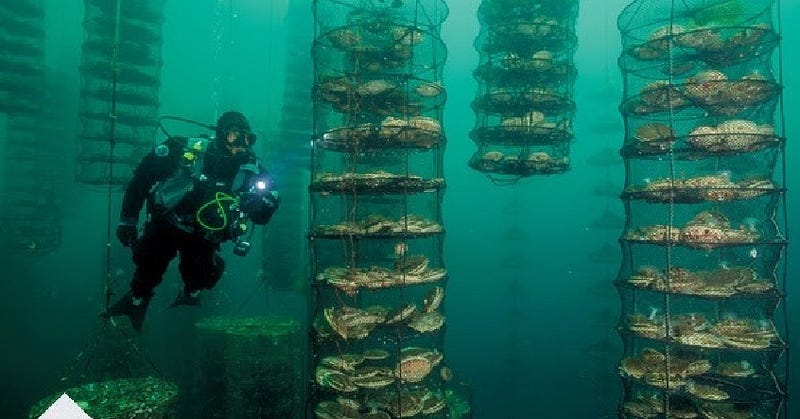The Ultimate Eco-Friendly Livestock: Are Oysters the Solution?
Written on
Chapter 1: Rethinking Livestock Farming
The practice of traditional livestock farming has faced significant criticism in recent years, and justifiably so. Intensive farming methods have resulted in animal suffering, with many creatures confined to cramped conditions and enduring distressing lives. This approach yields lower-priced products, which, despite ethical concerns, continue to see high demand.
Conversely, free-range and organic farming practices offer animals a vastly improved quality of life, leading to healthier food products. For example, organic eggs and milk often boast superior flavor because the animals are nourished with natural diets and experience less stress. However, these high-quality products often come at a premium, which not everyone is willing to pay.
While one could argue that both intensive and organic farming negatively impact the environment—given that cows are responsible for about 40% of methane emissions—should we really pit one farming method against another?
Certainly, reducing meat consumption or adopting a vegan lifestyle is an option, yet animal husbandry is deeply entrenched in human history. It has sustained us for thousands of years, and unless we find efficient lab-grown alternatives, it is likely to persist, regardless of our ethical beliefs.
But what if there was a livestock option that avoided these issues altogether? An animal that could be farmed intensively without causing suffering, required less space, and positively contributed to the environment?
Surprisingly, that animal is the humble oyster. While they might not be everyone’s favorite, they could very well be the ideal livestock for both humanity and the planet.
Section 1.1: The Remarkable Benefits of Oysters
Oysters are small mollusks protected by shells, thriving by filtering the ocean water for nutrients. They have existed for over 200 million years, serving as a crucial food source for various species, including humans.
Historically, oysters have been farmed since ancient times, with the Romans valuing their shells, meat, and pearls as valuable commodities. The town of Whitstable in Britain even hosts an annual oyster festival, celebrating this rich heritage.
Nutritionally, oysters are exceptional. A serving of six medium-sized oysters contains only about 50 calories but is packed with nutrients. A 100-gram portion can provide 7 grams of protein, 80% of the daily Vitamin D requirement, and an impressive 324% of the daily Vitamin B12 intake, along with other essential minerals like zinc and copper.
Additionally, they are a significant source of omega-3 fatty acids, which can enhance brain health and lower the risk of conditions such as heart disease and type 2 diabetes. Thus, many consider them a superfood due to their rich nutrient profile.
The first video discusses the drawbacks of certain livestock for beginners and highlights why oysters could be a better choice.
Section 1.2: Economic and Environmental Advantages of Oyster Farming
A major challenge with traditional animal farming is the vast amounts of land and feed required. For instance, a dairy cow typically needs about 10 square meters of space and consumes around 50 kilograms of feed daily. Livestock currently occupies nearly 80% of agricultural land but only produces 20% of the world's calorie supply, indicating a glaring inefficiency.
Fish farms also require significant resources; for every kilogram of farmed salmon, three kilograms of feed are needed.
In contrast, oysters thrive in vertical underwater gardens, allowing for high-density farming in a minimal footprint. Imagine underwater forests brimming with oysters; while they may not be calorically dense, properly managed farms could potentially alleviate global hunger.
Maintenance is minimal for oyster farming, as they are filter feeders. They naturally sift the water for plankton and algae, making them easier to farm than traditional livestock. According to oyster farmer Andre Hughes from Scotland, the natural conditions in clean waters significantly enhance the flavor of farmed oysters.

Additionally, oysters play a crucial role in environmental health. Each oyster can filter up to 50 gallons (227 liters) of water daily, removing pollutants and chemicals. In one experiment, oysters significantly reduced contaminants in polluted water within 72 hours, showcasing their remarkable ability to purify the environment.
Chapter 2: A Case for Oysters in Sustainable Farming
While we may not be enjoying oyster burgers anytime soon, it's clear that oyster farming should be considered as a viable alternative to traditional livestock methods.
From an ethical perspective, some argue that consuming oysters aligns with vegan principles, as they lack a brain or central nervous system, making it unlikely for them to experience pain. Vegan chef Alexis Gauthier supports this view, stating that oysters are non-sentient and thus, he feels comfortable including them in his diet.
In contrast to cattle and poultry, oyster farming is not only ethical and efficient but also beneficial for the environment. Is there any other farmed animal that can rival this?
P.S. — If you want to stay updated with my posts, you can subscribe here! Additionally, consider supporting my work and other writers by signing up for a Medium membership for just $5 a month. Your support helps me directly, at no extra cost to you. Regardless of your choice, I appreciate your time in reading this article and hope you found it informative.
About Me — Sajjad Choudhury
An ENFP Londoner with a wealth of experiences.
The second video explores the best and worst livestock choices for beginners, including a discussion on the benefits of oysters.